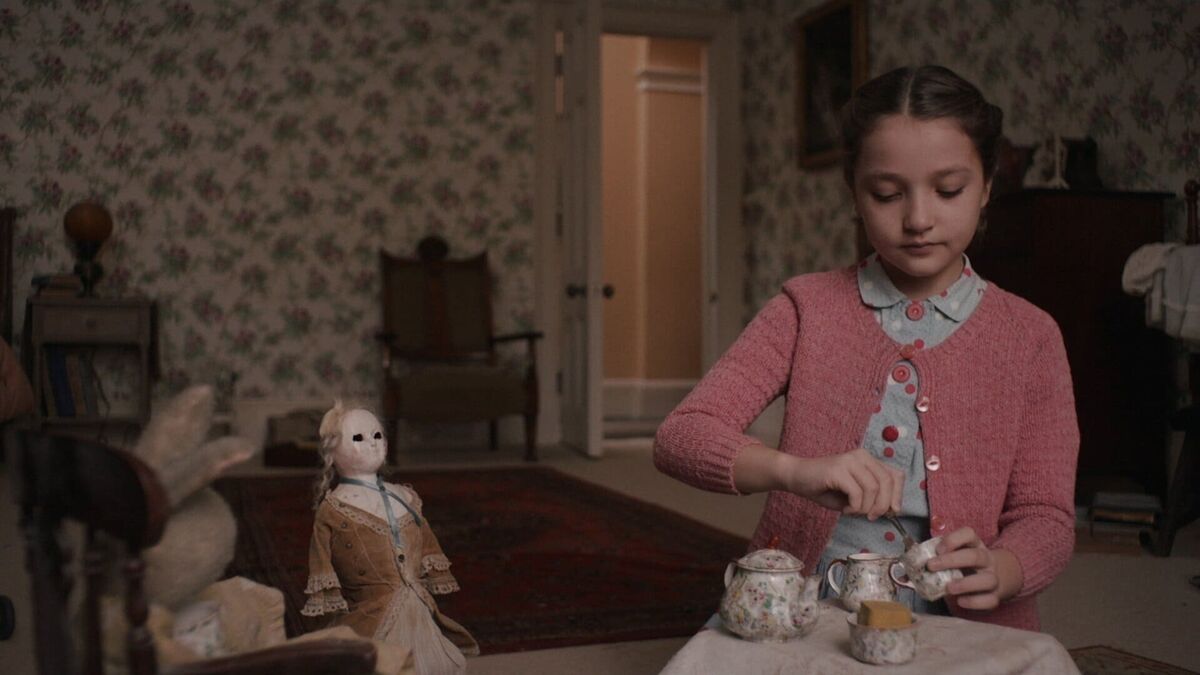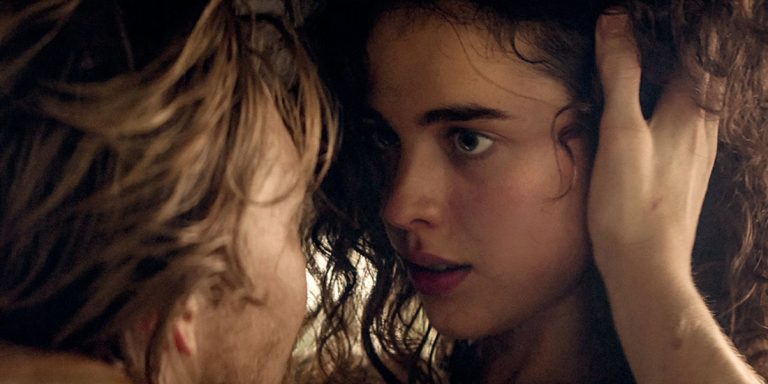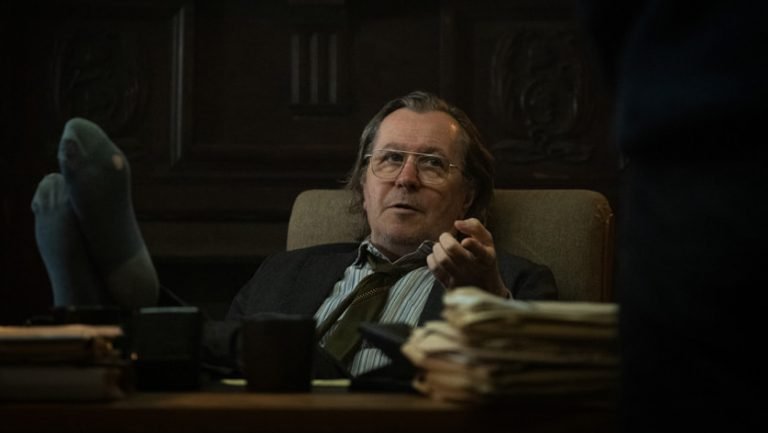The Banishing (2020) Ending, Explained & Themes Analyzed: The Banishing (2020) is a haunted house film that tries to balance the horrors of the historical past and the supernatural. Set in 1938, Britain, Christopher Smith’s The Banishing touches upon the uncertainties of these violent times as the frenzy of fascism is spreading its wings over Europe. The narrative also indicts the oldest oppressive institution, the Church, and how it controlled female bodies through cruel and narrow-minded beliefs. Though The Banishing’s merging of ghostly terror with turbulent political realities reminds us of films like Pan’s Labyrinth (2006) and Under the Shadow (2016), the film never comes alive.
Despite a solid gothic period atmosphere and a talented cast, the underwhelming writing (by a trio of screenwriters – David Beton, Dean Lines, and Ray Bogdanovich) and a too-tame directorial approach doesn’t fully realize the thematic and narrative potential of The Banishing. Nevertheless, you can give it a chance if you like your haunted house stories with a touch of sociopolitical commentary. Now let’s have a detailed look into The Banishing’s plot and the significance of its themes.
Recommended Read: Rosemary’s Baby (1968): Rethinking the Monstrous Mother in Popular Culture
The Banishing (2020) Movie Plot Explained:
A Haunted Manor’s New Residents
The Banishing opens with a vicar sitting in front of a tri-fold mirror and reading from his Bible; the verses related to ‘sexual immorality.’ The verse warns about ‘lustful passions’ and having sex for pleasure. He is interrupted by a sound from the next room. The vicar goes to investigate it and sees himself brutally murdering his wife. Before we conclude whether the vicar is suffering from a hallucination, the scene cuts to a man arriving in a car to the manor.
His identity is later revealed to be Bishop Malachi (John Lynch). He is met by the distressed Dr. Sutter (Jason Thorpe), who says it’s too late. The Bishop reaches the vicar’s room to be greeted with the ghastly murder scene of the vicar’s wife, and the vicar has hanged himself. Instead of reporting the crime, the Bishop asks the doctor to clean up.
During the opening credits, we see a strange red-headed man (Sean Harris) dancing a tango with a woman. Then the title card says ‘Three Years Later,’ as new residents arrive at the secluded manor. Known as the Morley Manor, a family of three move into it. Reverend Linus Forster (John Heffernan) is transferred to the region by Bishop Malachi, asking him to restore the faith of the Churchgoing people in these times of doubt and uncertainty. His new wife, Marianne (Jessica Brown Findlay), and her daughter, Adelaide (Anya McKenna-Bruce), are the other two occupants.
The ten or 11-year-old Adelaide is quick to explore the house and finds a creepy eyeless doll in the playroom, whereas the adults look at the well-maintained garden by the deaf housekeeper, Betsy (Jean St. Clair). Through Linus and Marianne’s conversation, we learn that the murder-suicide of previous residents Stanley and Beatrice Hall isn’t known to them. The Bishop has told Linus that the Halls have moved to Australia. Linus sounds anxious about building the congregation anew, and Marianne is supportive and encouraging. Linus also looks too pious and controlling as he mildly reprimands Adelaide for touching the dinner before he finishes his prayer.
The Looming Specter of Fascism
Later in the night, as Marianne tucks Adelaide into her bed, she looks at the weird doll and also at the even more creepy monk dolls of three adorned with brown hoods. As it’s the case with most of the haunted house films featuring kids, Adelaide has an imaginary friend or companion named Veronica, who ‘whispers things’ to her. Later, Marianne tries to consummate her marriage with Linus. However, the Reverend feels great shame as he is about to kiss his wife. He rebuffs her advances, and they sleep in different rooms.
Before going to sleep, Linus reads the same verses regarding ‘sexual immorality’ as Stanley Hall in the opening scene. Meanwhile, Marianne hears a noise while sitting in front of a dressing mirror. She can feel someone or something’s gaze on her. The camera looks at her through a small hole in the wall. Who is beyond the wall? As she peers into the hole in the wall, we get a glimpse of Marianne herself, walking through the darkly lit corridors of what looks like a mental asylum. Is it a vision Marianne has, or is it a memory from the past?
It’s morning, and at the breakfast table, Marianne talks about noises, and Linus says it could be mice or rats. Adelaide asks, “Are you talking about voices?” The kid says nothing when Marianne presses her on what she’s talking about. Linus asks his wife and daughter to go to a movie in the town.
Unfortunately, the newsreel about Hitler’s growing power in Europe unsettles Marianne and Adelaide. As they leave the cinema, the mother and daughter are seen by the stranger with a shock of red hair. Subsequently, Marianne is seen talking with a man in a friendly manner. Linus watches it from afar, and he feels jealous.
What Does the Red-Haired Stranger Say About the Morley Manor?
At the church, Linus is visited by the same stranger. Linus is seen practicing for his first sermon. He is of the opinion that violence begets violence, and hence the war, whether waged for right or wrong reasons, is a sin.
Upon hearing this, the stranger, a veteran of the Great War, ridicules him for his judgment. The stranger knows everything about Linus and talks about the Minassian Order, to which the local monastery belonged long ago. He says the manor the reverend’s family has taken residence is built on the ruins of the Minassian Order, who are known for their misogyny, violence, and brutality. He further asks if he has heard any whispers or voices or had any temptations. Enraged by the stranger’s intrusion, Linus tries to throw him out, but he asks if his wife, Marianne, is being tricked by the house.
Finally, the stranger reveals the truth about the Halls. He says the Halls were buried in a nearby tomb three years ago. Linus finds it hard to believe and says the Halls have happily moved on to Australia. The stranger warns about Bishop Malachi’s duplicitous nature, that Marianne and Adelaide are not safe in the house, and that they will start losing their mind. Despite throwing the stranger out, Linus is devastated by his words. He later goes into the woods to investigate the tomb.
Does Marianne Have a Dark Past?
Meanwhile, Marianne and Adelaide play an innocent hide-and-seek game of ‘What time is it, Mr. Wolf?’ However, the atmosphere is filled with dread as Marianne is unable to find Adelaide’s hiding place. She even goes down to the dark basement with a torch in hand. There she sees an oval-shaped mirror that reminds us of the one in Mike Flanagan’s Oculus (2013). In fact, the mirror seems to be an entryway into alternate dimensions like the ghostly realm. Marianne is soon scared by Adelaide as she emerges from the dark.
Back at the Church, Linus finds Stanley Hall’s Bible, which is defaced with crude drawings. He takes it with him to the manor and is surprised to find Bishop Malachi waiting for him. As a woman who speaks her mind, Marianne says that she finds it disconcerting to sleep in a manor when the whole of Europe is suffering due to fascism. She also calls fascism as ‘truly vile’ and leaves the men. Bishop Malachi is visiting Linus with ulterior motives as he reminds Linus about how securely he is placed here with a generous stipend. Moreover, he talks about Marrianne. While he calls her ‘fiery and independent.’ the Bishop also hints about her giving ‘the daughter away,’ and that it was Linus who saved her.
Before long, the Bishop touches upon the primary reason for his visit: to talk about Linus’ encounter with the stranger. The Bishop warns him about the man and takes leave once he is sure of Linus’ loyalty to him. During dinner, Marianne talks about contributing to the war effort. Linus disapproves of it and wants nothing to do with the war. Marianne counters him by emphasizing that they should do something against the Fascists instead of simply preaching that war is a sin. Linus gets angry, orders Marianne not to give away anything, and asks her not to talk with the men in town. He hints that she should behave like a ‘Vicar’s Wife.’ Naturally, Linus’ words enrage Marianne, and she questions why he hasn’t yet treated her like a wife.
The Nightmarish Visions of Marianne
Meanwhile, Adelaide is seen increasingly attracted to the spell of the oval-shaped mirror and is often seen playing with the eyeless doll and the brown-hooded monk dolls. During a casual conversation with Adelaide, Marianne is shocked to learn that the girl thinks that she is not her biological mother. In the middle of the night, Marianne wakes up to find the hooded monks in the garden, brutally murdering the housekeeper, Betsy. She rushes to rescue Betsy, but she is lying dead. Linus wakes up to Marianne’s screams, but she is just sitting by herself. Marianne snaps out of the trance and realizes that she has only experienced a vision.

The following morning, she visits the local doctor, who is disturbed once he learns that Marianne is the new vicar’s wife and they are staying at the haunted manor. Doctor Sutter was the one who worked with Bishop Malachi to cover up the murder-suicide of the previous vicar. Later, he is seen at the local bar, conversing with the stranger, whose name is Harry Reed, an occultist. The doctor confesses his misgivings about the Bishop’s decision to make a family with a kid to stay in such an evil place.
Soon, the Bishop interrupts their conversation. He threatens Harry Reed as Harry questions the Bishop’s sinister intentions for exposing the reverend’s family to evil. Furthermore, Harry belittles the Bishop for his Nazi sympathies and gives him Sieg Hail salute. Offended by this encounter, Bishop Malachi employs thugs to beat up Harry Reed.
What does Harry Reed say About the Evil Lurking in the Manor?
While Linus gets more obsessed with the fate of the Halls, Betsy, the housekeeper, asks Marianne to meet a man who can help her from the malevolent visions. The man, of course, is Harry Reed.
He tells Marianne how her visions are connected to the Minassian Order monks, who practiced a sick, perverted version of the Christian faith. They particularly tortured women, whom they believed to be ‘immoral,’ and indulged in self-mutilation, believing that it would bring them closer to God. Harry says Marianne’s daughter Adelaide is born out of wedlock, which Marianne vehemently denies. Harry warns that feelings of denial and shame can give the evil lurking in the shadows more power.
Linus reaches home at night. He investigates the basement and has a vivid vision of Marianne having sex with someone. He walks back up, only to see Marianne reaching home after visiting Harry. They engage in a confrontational dialogue. In the morning, after a sermon in the Church, Marianne comes back home to find Bishop Malachi waiting for her. He reminds Marianne of her dark past, where she spent some time in a mental asylum while pregnant with Adelaide. The Bishop states how he was instrumental in bringing Adie back to her instead of being sent to an orphanage and how he was the reason she got introduced to Linus. Finally, he intimidates Marianne that all of it can be taken back.
The Banishing (2020) Movie Ending Explained:
Who is the Tortured Blind Woman?
In the night, Marianne sees Adelaide standing in front of the mirror. Marianne is unable to move while a blind woman walks into the mirror, and Adelaide follows her. Having lost Adelaide to the ghostly realm, Marianne seeks her husband’s help, who is heavily drunk and ready to burst into violence. Therefore, she goes to Harry Reed. They come back to see Linus in a trance, possibly possessed by the evil monk, and he has brutally killed Betsy (just like in her vision).
Harry reveals that the monks have tortured and killed a pregnant woman and her illegitimate child. She has taken Adelaide as revenge for the torment she endured because of the Church’s policies. Now Marianne faces the threat of the monks as she has also had a child out of wedlock. Harry brings Linus out of the trance, and the three go down to the basement, which is where they believe the blind woman was held. Harry sets up a ritual. He extinguishes light to plunge the space into darkness, and it is up to Marianne to travel through the darkness to overpower the evil monks and save Adelaide from the wronged woman.
Soon, Marianne finds herself strapped to the wooden table as the three hooded monks huddle around to torture her. Marianne expunges her feeling of shame and declares, “I will not hide in shame. Because I feel no shame.” She says they are the embodiment of shame. Next, Marianne is transported to a dark place of cells. She plays a game of Mr. Wolf and is guided by Adelide’s voice. Marianne finds her daughter in a cell with the blind woman and promises her that she and her child will get a proper burial. Marianne further states, “History will be rewritten.”
What’s the Ulterior Motive of Bishop Malachi?
Keeping up with the promise, Linus gives a proper Christian burial to the woman and her child (their bones are found in the cell). The eyeless doll is also buried in the casket. However, some men unearth the coffin at night and take out the remains of the woman who haunted the manor. It was acquired by none other than our Bishop Malachi. He travels with it to Stuttgart, Germany. It looks like the Bishop’s reason behind housing families at the evil Morley manor is to find the woman’s bones. As he believed, the child Adelaide had found it. Why? It’s well known that Nazis were obsessed with occultism, though cinema has often twisted that history into farfetched stories. It becomes clear that Bishop Malachi is more than a Nazi sympathizer; he is an occult artifact collector for the Nazis.
The Banishing ends with Linus delivering a sermon to his parishioners. He quotes the words attributed to British statesman and philosopher Edmund Burke, “The only thing necessary for the triumph of evil is for good men to do nothing.” Linus finally condemns the evil that threatens to engulf Europe and asks his parish to pray that this evil does not spread further.
The Banishing (2020) Movie Themes & Visual Motifs Analyzed:
Sexism & Misogyny
The Banishing indicts faith-based sexism and misogyny. The Catholic Church’s harsh treatment of women over different centuries is well-documented. Though the Church has undergone many reforms by the time the narrative is set, it’s evident how the ideas of sin and shame are still associated with female bodies and sexuality. While Reverend Linus accepts his wife, Marianne, and her child, Adelaide, his strong religious beliefs inculcate internalized notions of misogyny in him. This, combined with whatever darkness resides within the manor, escalates his feelings of jealousy and suspicion to murderous rage.
On the other hand, Bishop Malachi is shown as the personification of the Church’s sexist beliefs. He despises Marianne and feels he can control her by using the past against her. Perhaps, the tragic victim of religious beliefs is the tortured woman who haunts Morley Manor.
Extremist Beliefs
Whether old, twisted Christian beliefs or the rise of fascism, The Banishing shows that extremist ideas always threaten humanity and our reasoning. Morley Manor houses the evil that carried out sick crimes against women. But a larger evil seems to have plagued the continent in the late 1930s, which also commits the unpardonable crime of dehumanization. As shown in the film’s ending, extremism denies peace even to the dead.
Mirrors & Doppelgangers
The Banishing is the only film in British filmmaker Christopher Smith’s oeuvre where he isn’t involved in the scripting process. Yet the film carries some of his familiar visual motifs, including the use of mirrors and doppelgangers. Smith and his cinematographer Sarah Cunnigham have done an excellent job in creating an authentic atmosphere of the manor, though the narrative doesn’t provide plenty of scares. Like in Triangle (2009), mirrors are everywhere, and in Banishing, the reflective surfaces are doorways to the world of spirits.
As we previously saw in Severance (2006) and Triangle, Smith seems to love the visual idea of a character looking at herself/himself. In Banishing, the doppelganger of Marianne roaming the hallways is not only unsettling but also takes us into the dark recesses of her mind. The doppelgangers also represent the dissociation of self as a result of the madness. Moreover, in the staging of Stanley Hall and Linus reading the same Bible verses, Smith hints at a mirroring.
Eventually, some of the timeworn scare tactics and undercooked plot elements stop The Banishing (96 minutes) from becoming an effective horror cinema.






![Only Lovers Left Alive [2013]: A Haunting & Hypnotic Mood Piece](https://79468c92.delivery.rocketcdn.me/wp-content/uploads/2017/09/only-lovers-left-alive-2-768x393.jpg)
![Wild Men [2021] Review: Humour at the Time of Mid-life Crisis](https://79468c92.delivery.rocketcdn.me/wp-content/uploads/2022/06/Wild-men-2021-768x433.jpeg)

